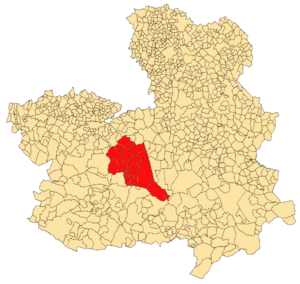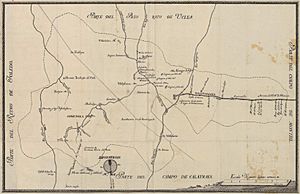Campo de San Juan facts for kids

The Campo de San Juan was a special territory in La Mancha, Spain. It was like a large estate owned by the Order of St. John, also known as the Knights Hospitaller. This area was very important to them. It covered parts of what are now the Toledo and Ciudad Real provinces. The main towns in this area were Consuegra and Alcázar de San Juan.
Contents
History of Campo de San Juan
The Knights Hospitaller first arrived in La Mancha in 1162. They were given several villages. In 1183, King Alfonso VIII gave them the Castle of Consuegra. This was a very important moment for the Order in Spain. It helped them create their large territory in La Mancha.
Where was Campo de San Juan?
The Campo de San Juan was a big area. It covered about 3,983 square kilometers. This included parts of the Montes de Toledo mountains. It bordered other important areas. These included the Campo de Calatrava and the Campo de Montiel. Those areas belonged to other knightly orders.
How was the Campo de San Juan managed?
The Knights Hospitaller were an international group. They were not fully part of the Spanish Kingdom. This meant their leaders, called priors, kept a lot of power. They could manage the land and make decisions about justice. This was different from other Spanish knightly orders.
Changes over time
By the early 1500s, the town of Alcázar became more important. Consuegra, which was a fortress, became less central. There was a disagreement over who should lead the Order. This led to the territory being split into two parts. Some towns went to one leader, and others to another.
- First Group of Towns: Consuegra, Madridejos, Camuñas, Urda, Turleque, Tembleque, Villacañas, Villarta de San Juan, Herencia, and Arenas de San Juan.
- Second Group of Towns: Alcázar de San Juan, Argamasilla de Alba, Quero, and Villafranca de los Caballeros.
The territory was finally reunited in 1566.
Campo de San Juan in the 1700s
In the 1700s, the Campo de San Juan was very powerful. It was one of the richest areas in the Kingdom of Toledo. It had a lot of land and people. By 1769, it included 14 towns:
- Consuegra
- Alcázar
- Madridejos
- Herencia
- Villacañas
- Tembleque
- Villafranca
- Urda
- Argamasilla
- Quero
- Camuñas
- Villarta
- Turleque
- Arenas
Later, in 1802, the Order of Malta's groups in Spain became fully part of the Spanish Crown. This meant the Spanish king took over their control.
See also
 In Spanish: Campo de San Juan para niños
In Spanish: Campo de San Juan para niños


